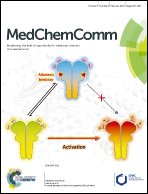Hepatocellular targeted α-tocopherol based pH sensitive galactosylated lipids: design, synthesis and transfection studies†
Abstract
Receptor mediated gene delivery to the liver offers advantages in treating genetic disorders such as hemophilia and hereditary tyrosinemia type I (HTI). Prior findings demonstrated that tethering the D-galactose head group to cationic lipids directs genes to the liver via asialoglycoprotein receptors (ASGPRs). In our continued efforts to develop safer and efficient lipofectins, we demonstrated that cationic lipids bearing α-tocopherol, an antioxidant, as a hydrophobic domain could deliver genes efficiently with high safety profiles in multiple cell lines. Towards developing ASGPR targeted pH sensitive cationic lipids, we have designed a galactosylated cationic lipid (Toc-Gal) with α-tocopherol as the hydrophobic core covalently connected with a pH responsive triazole moiety and a non-targeting control lipid (Toc-OH) without the galactose head group. In this study, we present the design and synthesis of a pH sensitive galactosylated cationic lipid (Toc-Gal), its comparative transfection biology, cellular uptake studies, serum stability and cytotoxicity profiles in both ASGPR positive and negative liver cells, i.e. HepG2 and SK-Hep-1, respectively.



 Please wait while we load your content...
Please wait while we load your content...